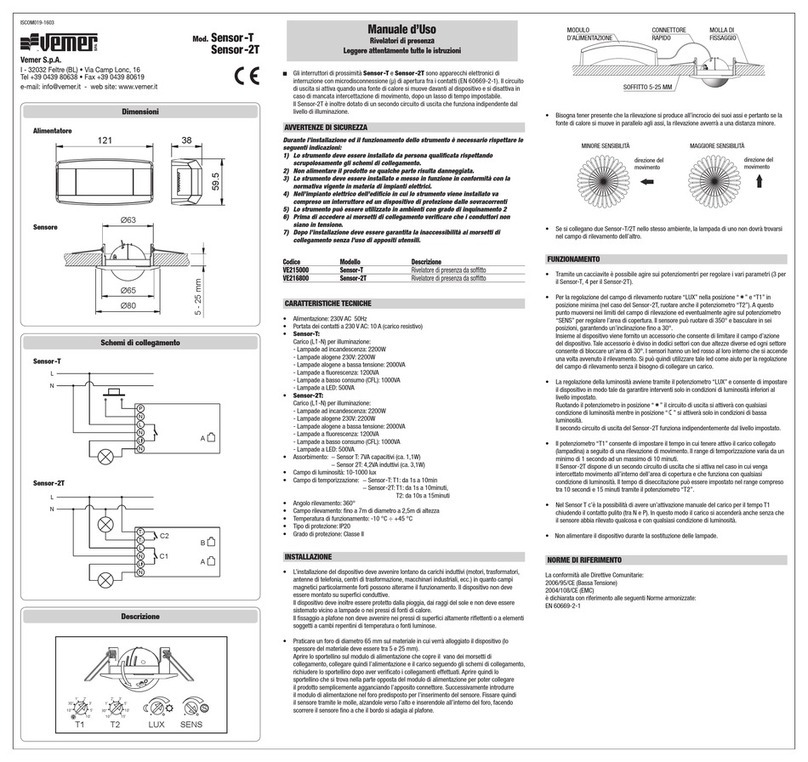
Mod. Sensor LED
Sensor 2LED
Manuale d’Uso
Rivelatori di presenza con faro a LED
Leggere attentamente tutte le istruzioni
Gli interruttori di prossimità
Sensor LED
e
Sensor 2LED
sono apparecchi elettronici di
interruzione con micro-distanza (µ) di apertura fra i contatti (EN 60669-2-1). Dispongono
di un faro a LED (singolo per Sensor LED, doppio per Sensor 2LED) che si attiva quando una
fonte di calore si muove davanti al dispositivo e si disattiva in caso di mancata intercettazione
di movimento, dopo un lasso di tempo impostabile. Sono dotati inoltre di un relè per il
collegamento di un dispositivo esterno (un faro supplementare, un allarme acustico,...) che si
attiva in contemporanea all’accensione del faro.
AVVERTENZE DI SICUREZZA
Durante l’installazione ed il funzionamento del dispositivo è necessario attenersi alle
seguenti prescrizioni:
1) Il dispositivo deve essere installato da persona qualicata rispettando
scrupolosamente gli schemi di collegamento
2) Non alimentare o collegare il dispositivo se qualche parte di esso risulta danneggiata
3) Nell’impianto elettrico dell’edicio in cui il dispositivo va installato deve essere
presente un interruttore e un dispositivo di protezione dalle sovracorrenti
4) Prima di accedere ai morsetti, assicurarsi che i conduttori da collegare non siano in
tensione.
Codice Modello Descrizione
VE767200 Sensor LED Rivelatore di presenza 200° con faro LED 13W
VE767300 Sensor 2LED Rivelatore di presenza 200° con 2 fari LED 2x13W
CARATTERISTICHE TECNICHE
• Alimentazione: 230V AC 50Hz
• Tipo di faro LED:
- Sensor LED: 1x13W, 1000 lm
- Sensor 2LED: 2x13W, 2000 lm
- Temperatura colore: 4000K
• Relè con potere di interruzione di 10A / 250V AC (su carico resistivo)
• Sezione massima dei cavi: 2 x 1,5 mm2
• Campo di luminosità: da 5 a 1000 lux
• Tempo di intervento: da 3 secondi a 30 minuti circa
• Angolo di rilevamento: 200°
• Campo di rilevamento: − frontale 12m a 20°C
− laterale: 8m a 20°C
• Temperatura di funzionamento: -20 °C ÷ +40 °C
• Grado di protezione: IP55
• Classe di isolamento: II
INSTALLAZIONE
• L’installazione del dispositivo deve avvenire lontano da carichi induttivi (motori,
trasformatori, antenne di telefonia, centri di trasformazione, macchinari industriali, ecc.)
in quanto campi magnetici particolarmente forti possono alterarne il funzionamento.
Il dispositivo deve inoltre essere protetto dai raggi del sole e non deve essere sistemato
vicino a lampade, nei pressi di elementi soggetti a sbalzi di temperatura (riscaldamento,
climatizzazione) e lontano da superci altamente riettenti.
Rimuovere il coperchio allentando la vite in basso al dispositivo e ssare il coperchio base
sul punto della parete in cui lo si vuole installare (ad un’altezza di 2-3 metri).
La direzione del movimento della fonte di calore deve essere trasversale alla lente del
dispositivo perchè il rilevamento avviene per incrocio dei fasci; per questo se la fonte si
sposta parallelamente ai fasci, il rilevamento avverrà a una distanza inferiore. Anche la
temperatura ambiente inuisce sulla sensibilità del dispositivo, e tanto più è vicina alla
temperatura dell’oggetto da rilevare, tanto più scadente sarà la sensibilità.
• La testina può ruotare orizzontalmente di circa 180° e verticalmente di 45°. Per regolare
il campo di rilevamento bisogna:
− ruotare il selettore tempo di intervento no al minimo e il selettore di luminosità
no a ( );
− vericare la copertura spostandosi all’interno dei limiti del campo di rilevamento.
Il dispositivo ha inoltre in dotazione dei limitatori dell’area di rilevamento che
consentono, se applicati alla lente, di escludere uno o più settori del campo di rilevazione.
• Per regolare la luminosità, ruotare il relativo selettore verso la posizione ( ); quando la
luminosità ambientale è quella desiderata ai ni del funzionamento, iniziare a ruotare il
selettore in senso contrario, no a illuminazione avvenuta.
• Per regolare il tempo di intervento bisogna ruotare il selettore ( ) nella posizione
desiderata: la scelta va da un minimo di 3 secondi a un massimo di 30 minuti. Tale tempo
viene riavviato a ogni intercettazione del rivelatore.
FUNZIONAMENTO
• All’accensione e dopo ogni ripristino dell’alimentazione a seguito di un blackout, il
sensore attiva il faro LED e l’eventuale carico collegato per 30 secondi, indipendentemente
dal livello di luminosità e dall’effettiva presenza di movimento nel campo di rilevamento.
• Durante il normale funzionamento, quando il livello di luminosità scende al di sotto
di quello impostato, il dispositivo si predispone al rilevamento, segnalando questa
condizione tramite il lampeggio del led interno.
NORME DI RIFERIMENTO
La conformità alle Direttive Comunitarie:
2014/35/UE (LDV)
2014/30/UE (EMCD)
è dichiarata con riferimento alle seguenti Norme armonizzate:
EN 60598-1/EN 60598-2-1
Dimensioni
Schema di collegamento
Sensibilità
Fissaggio a muro
MAGGIORE SENSIBILITÀ
direzione del
movimento
direzione del
movimento
MINORE SENSIBILITÀ
Sensor LED
Sensor 2LED
A1
100
135
A2
150
185
L
175
205
P1
155
170
P2
175
190
A1
A2
L
P1
Sensor LED
Sensor 2LED
A1
100
135
A2
150
185
L
175
205
P1
155
170
P2
P2
175
190
P1
Sensor LED
Sensor 2LED
A1
100
135
A2
150
185
L
175
205
P1
155
170
P2
L' N L
L
N
µ
230 V AC
LAMPADA
SUPPLEMENTARE
L' N L
Incandescenti 1000 W
Fluorescenti non compensate 500 VA
Fluorescenti compensate 150 VA
Alogene (230V) 1000 W
LED 125 VA
Basso consumo (CFL) 250 VA
ISCOM058-1708






















